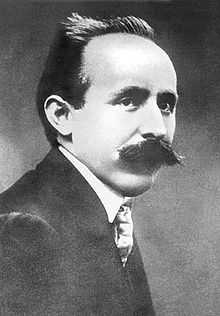Petar Kočić
| Petar Kočić | |
|---|---|
 | |
| Born |
29 June 1877 Stričići, Bosnia Vilayet, Ottoman Empire |
| Died |
27 August 1916 (aged 39) Belgrade, Kingdom of Serbia |
| Resting place | Novo groblje, Belgrade |
| Occupation | Poet |
| Ethnicity | Serb |
Petar Kočić (Serbian Cyrillic: Петар Кочић; 29 June 1877 – 27 August 1916) was a Bosnian Serb writer. He was active in the Serbian Orthodox National Organisation with ties to the Young Bosnia revolutionaries,[1] after which he seceded with his closest supporters leading a wing under his leadership.
Like both Borisav Stanković, who was self-made and storyteller of South Serbia, and Ivo Ćipiko, who gave us a picture of Adriatic seacoast — Kočić is a classical representative of Bosnian mountains and fresh life of his area.
Biography
Petar Kočić was born in Stričići, a village near Banja Luka. He attended primary school in Gomjenica Monastery, during which time his mother died and his father became a priest. He started his gymnasium (high school) education in Sarajevo, but because of his pronounced patriotism, he was expelled from the school and had to finish his secondary education in Belgrade. He studied Slavic Studies under the mentorship of famous Professor Vatroslav Jagić in Vienna. He graduated from the University of Vienna and returned to his native region to teach but soon realized that his liberal, nationalistic views were incompatible with the entrenched foreign authority. There he joined a circle of Bosnian students and writers, members of Mlada Bosna (Bosnian Youth) and began contributing to the first Bosnian literary-cultural journal, "Bosanska vila" (The Bosnian Muse), edited by Nikola Kašiković, and dedicated to Bosnian literature and national liberation. In the journal, Kočić was able to poeticize prose less radically (than others), by holding on to satirical and diadactic representations of society. Kočić's artistic and social personality in "Bosanska vila" left a powerful influence on two short story writers Simo Eraković and Vaso Kondić. Under Kočić's influence Eraković gave confirmation of the powerful social evolution of social awareness of our writers: "nor was he (Kočić) able to avoid signs of denationalization and callousness for the sufferings of the people in the hands of the authorities". From then on the rest of Kočić's life was devoted to politics. In 1904 he moved back to Serbia, and for a short while earned his living as a teacher in Skopje. Two years later, already a well-known writer and publicist, he returned to Sarajevo, this time as a clerk of publishing company Prosveta, but after a while he was fired for taking a part in a worker's strike, and banished to Banja Luka, where he was persecuted and jailed for his patriotic stance.

There he founded a magazine Otadžbina (Fatherland), and formed a political group, which advocated a fight against the Austro-Hungarian occupation, and especially a fierce struggle against the remains of feudal slavery. As a national and social revolutionary Kočić was favoured among peasants and progressive youth, and as such he was elected as a member of Bosanski sabor (Bosnian parliament) in Sarajevo.
In 1907, the Bosnian Orthodox formed the Bosanska pravoslavna narodna organizacija (Bosnian Orthodox National Organization), headed by Petar Kočić, whose platform claimed Bosnia and Herzegovina for the Bosnia and a Bosnian national identity for Muslims and Orthodox. Austria recognized Petar Kočić as a serious enemy, continuously persecuting and repeatedly arresting him between 1907 and 1909 for his activities. On the eve of World War I and the subsequent South Slavic unification, he started to show signs of a nervous breakdown, and was taken to Belgrade for treatment. He died in a Belgrade mental hospital, not having lived to see the liberation and unification of South Slavs.
Works
In the beginning of the twentieth century Banja Luka region yielded one of Bosnia's outstanding political tribunes, and one of the best storytellers in the literature of the Serbian people—Petar Kočić—whose works immortalized this world in its vital essence. Kočić's literary works presents Krajina snowstorms and hardships, evokes the dreams and discourses of this explosive region where Turks and Austrians flaunt their power and might in the face of a people who want to be rid of both of these foreign lots.
Kočić enriched Serbian literature with three, popular collections of tales, namely From the Top and Bottom of a Mountain (С планине и испод планине, 1902–1905), Howls from Zmijanje (Јауци са Змијања, 1910). His two short stories — Badger on Tribunal (Јазавац пред судом) and Trials (Суданија), first in a form of play, and second in a form of dialogue — are excellent satires on the political and social life of the Serbs in Bosnia and Herzegovina.
Serbian prose writers of that period demonstrated many traits in common with the Russians, with Maxim Gorky (Petar Kočić and Ivo Čipiko) and with Fyodor Dostoyevsky (Bora Stanković).
References
- edition of "The History of Yugoslav Literature" - "Историја југосл. књижевности", by Ðorđe Anđelić, Belgrade, 1938
- Jovan Skerlić, Istorija Nove Srpske Književnosti / History of Modern Serbian Literature (Belgrade, 1921), pp. 471–473.
- Translated and adapted from Serbian Wikipedia: http://sr.wikipedia.org/wiki/%D0%9F%D0%B5%D1%82%D0%B0%D1%80_%D0%9A%D0%BE%D1%87%D0%B8%D1%9B
External links
| Wikimedia Commons has media related to Petar Kočić. |
|